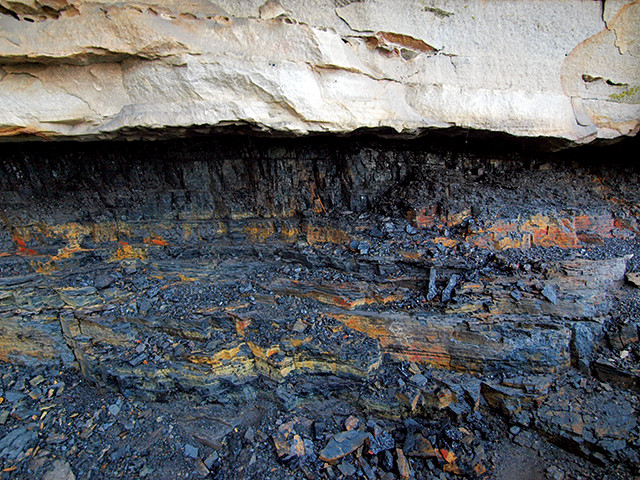
by Mary Caperton Morton Thursday, May 19, 2016

The majority of the world's coal dates to the Carboniferous Period. Credit: Mary Caperton Morton.
The Carboniferous Period is famous for supplying Earth with an abundance of coal deposits. According to one hypothesis, the formation of all this coal is explained by a proposed 60-million-year gap, or lag, between the spread of the forests globally about 360 million years ago and the rise of wood-eating microbes and fungi that could break down tough plant matter. But a new study refutes this idea, instead attributing the Carboniferous’ copious coal to the consolidation of the supercontinent Pangea.
When the “evolutionary lag” hypothesis was first proposed in the 1990s, “some in the scientific community were really enamored of it,” says Kevin Boyce, a geobiologist at Stanford University and an author of the new study, published in Proceedings of the National Academy of Sciences. “Despite plenty of evidence that the story doesn’t add up, it has refused to die.”
The evolutionary lag hypothesis hinges on the amount of lignin — a class of tough cell wall polymers that lend strength to plant tissue and are more resistant to degradation than other plant components — contained in trees and plants during the Carboniferous. Most species of modern trees contain large amounts of lignin, and if the same were true of ancient trees before microbes and fungi evolved to break it down, the lignin would have provided a huge source of carbon that could be converted to coal.
In the new study, Boyce and his colleagues surveyed Carboniferous coal samples from around North America and found that lignin was not the dominant plant constituent preserved in the coal. Many samples were composed mainly of lycopsids, an ancient group of plants that had little lignin in their cell walls. The researchers also found that coals high in lignin did not necessarily date to times when larger volumes of coal were produced, further suggesting that lignin content was not a substantial control on coal formation.
In addition to the prominent role that the evolutionary lag hypothesis attributes to lignin in forming Carboniferous coals, the hypothesis also suggests that fungi are rare or absent in the coals, says James Hower, a sedimentary geologist at the University of Kentucky who was not involved in the new study. But that’s just not the case, he says. In coal that’s hundreds of millions of years old, finding signs of life — whether from plants, bacteria, fungi, algae, insects or other animals — can be tricky, he says, but “there’s plenty of evidence for fungi in Carboniferous coals if you know where to look.”
Boyce says his team’s findings lend support to an alternate hypothesis: one that credits the abundance of coal formed during the Carboniferous to a combination of wet climate conditions and basin-forming tectonics that prevailed during the assembly of Pangea more than 300 million years ago.
“To form coal you need two basic conditions: wet tropics and a hole to bury organic matter in for a long period of time,” Boyce says. During the formation of Pangea, collisions between continents raised mountain ranges while downwarping adjacent crust, which created massive basins. These basins became ideal depositories for wet organic plant matter, which was buried, compressed and cooked over geologic time to form coal. Similar conditions likely also produced coal deposits during the Mesozoic Era, and the Paleocene and Eocene epochs, often in conjunction with mountain-building episodes such as the formation of the Rocky Mountains.
This tectonic- and climate-driven explanation for Carboniferous coals has been around for a while, Boyce says, but the new results make the case for it even stronger. “If you look at the stratigraphic distribution of coal over geologic time, it’s clear that fungi aren’t controlling accumulation rates,” because periods of coal formation come and go throughout the geologic record. But, he says, coal accumulation patterns make “a lot of sense in terms of wet climates and basins opening.”
© 2008-2021. All rights reserved. Any copying, redistribution or retransmission of any of the contents of this service without the expressed written permission of the American Geosciences Institute is expressly prohibited. Click here for all copyright requests.